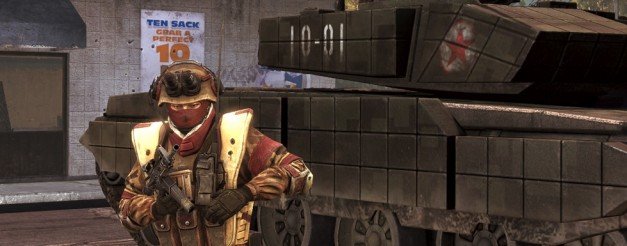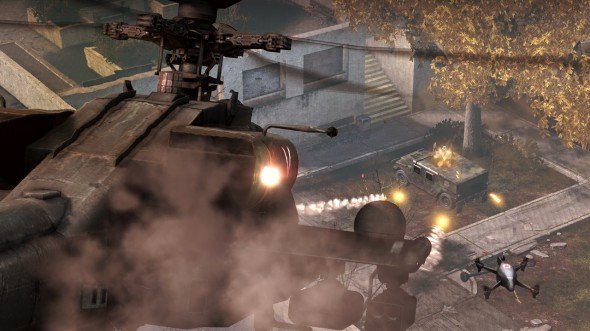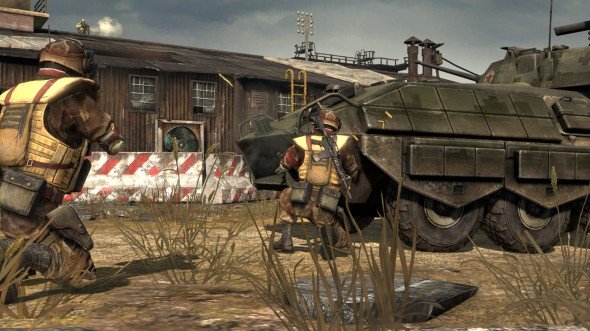
Kaos haven't been shy in touting Half-Life 2 as their inspiration. Of course they haven't – it's a convenient way of saying: “This is the best thing ever,” while maintaining a sense of plausible modesty. The parallels are all lined up, jostling for your attention. Mute protagonist, on-rails introduction, strong, humane female star and careful dramatic pacing – from ratcheted combat set pieces, to cutscene-free exposition. Check, check, a hundred times check.
Of course, there are plenty of significant differences, too. The gritty, exotic gravity gun-free world means you won't come across any contrived and out of place see-saw puzzles. And in a world where your enemies are human, rather than morally simplistic and headcrabs and barnacles, Homefront is forced to resort to shock tactics to convince you that these humans who are making your life so difficult are actually worth going through the anguish of killing.

On your short bus journey, Kaos Studios give you a short tour of life in the occupied suburbs of America. High fences have been erected. Citizens walk, hands on heads, under armed supervision. Any resistance is matched with lethal force, including a particularly well-placed shot that leaves a massive spatter on your bus window. The brutal icing on the juicy bloodcake – a mother tells her son to look away as she and his father are executed on a corner. It's so cruel. Why would these Koreans do that? Because they're evil, stupid. Kill them.
Only one thing is particularly jarring in this self-consciously immersive world of studied storytelling. After escaping, facing up to a number of near-futuristic turrets and being betrayed, you come to an area that's being used as a mass grave. It could have been a harrowing moment, as the full and terrible scale of the slaughter sinks in. Then, as a patrol arrives, you're told “Press X to hide in the mass grave”. It's like a hypnotist snapping his fingers. In an instant the magic dissipates and you're completely back in the room.
But that's a minor snipe, and the self-inflicted Valve comparisons end abruptly when we move onto the multiplayer. This is where Kaos Studios have their deepest roots – beginning with the Desert Combat mod for Battlefield which led to the MP-only Frontlines.

A quick recap of what we know: the moving battlefront from Frontlines is intact, and that allows the focus to drift across a large map as one team gains dominance. Then there are Battle Points, that you can earn in a variety of ways by benefitting your team, and which you are able to spend on ammo, drones, weapons, and vehicles. It's a fairer and more flexible system than Modern Warfare's kill-streak rewards. Everyone gets something, and you can help out your team in more ways than just popping off headshots – say, by using a recon drone to tag enemies, which earns you plenty of points, too.
The newest revelation is the Battle Commander – something Kaos describe as an AI general, dispensing missions to players as the game unfolds. These aren't like Section 8's player-triggered mid-game missions. The Commander silently notes your actions, and pretty much tells you to carry on. So, find a nice snipey spot and take out three enemies and you'll be given a one-star mission: snipe more enemies. Three more, and you'll be given a reward, and upgraded to a two-star mission. This will continue up to five stars, at which point you're earning bragging rights, battle points, rewards such as extra-strong flak jackets that battle points can't buy and XP that makes you stronger on a more persistent basis.
Keep up to date with the most important stories and the best deals, as picked by the PC Gamer team.
Best player getting souped-up gear: so far, so imbalanced. What's the catch? Well, the goals get slightly more challenging, but as you build your star ranking, more and more members of the opposing team will be offered a countermission to take you out. The result is intense, and forces you to balance the benefits of keeping your eye on the big prize – point capture, whatever – and the immediate Battle Point rewards of taking out a lone wolf who's doing a great job of murdering your team. Eliminate a fivestar hostile, and the rewards would be huge. You could respawn in a tank. Then who'd be on a kill-streak?

It's not just chain-killing that triggers a mission – tagging six enemies with a recon drone starts its own set of five-star missions. Tagging can be a cheap and easy way to build up battle points with little risk to your soldier – without Battle Commander, people tend to focus on the more tangible threat of bullets in the head. Being identified by the Commander as a real threat, and having a substantial reward offered for your destruction really does put a damper on this cheap tactic.
Watching a hardcore camper trigger a sniping mission, he's observed by a rocket-launching drone sent up by an enemy. He switches to his pistol and takes it out – which doesn't count towards his overall goal. These missions, then, encourage a single-minded approach – snipers should stick to sniping to get the rewards they feel they so richly deserve. But then, if you chose the sniper class at the loadout screen, you're probably OK with that.
There's also the worry that Battle Commander missions might provide an incentive to not act like a team, with one player unaware that his buddy might be on a Battle Commander mission. But that's down to the individual – selfish assholes will always dump you for a machine gun, and it's not something that's noticed during the playthrough. Discovering how the Battle Commander will interact with the moving battlefront and Battle Points system to create a coherent team experience will take considerably more than a couple of hours. While it seems slightly narrow in scope at the moment, it's an interesting system that – with tweaks – could equally be used to encourage varied play. It'll be interesting to see what form the Battle Commander takes in the finished product.

